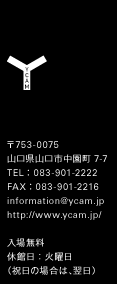WORK
Seiko Mikami “Desire of Codes” (comissioned by YCAM)
![[photo] Seiko Mikami“Desire of Codes”](images/DoC.jpg)
Large-scale installation at YCAM’s theatre hall
The “individual” visitor in a double role as a subject of expression and observation
This interactive installation consisting of three parts is set up in YCAM’s Studio A, a space that is normally used for theatre performances.
A large number of devices resembling tentacles with built-in small cameras are placed across a huge wall (Part 1), while six robotic “search arms” equipped with cameras and projectors are suspended from the ceiling (Part 2). Each device senses with insect-like wriggling movements the positions and movements of visitors, and turns toward detected persons in order to observe their actions. In addition, a giant round-shaped screen that looks like an insect’s compound eye is installed in the back of the exhibition space (Part 3). Visual data transmitted from each camera, along with footage recorded by surveillance cameras installed at various places around the world, are stored in a central database, and ultimately projected in complex images mixing elements of past and present, the venue itself and points around the globe, onto the screen. The compound eye visualizes a new reality in which fragmentary aspects of space and time are recombined, while the visitor’s position as a subject of expression and surveillance at once indicates the new appearances of human corporeality and desire.
Part 1: 90 Wriggling Wall Units
![[photo] 90 Wriggling Wall Units](images/DoC1.jpg)
90 devices are exhaustively distributed across a wall. As soon as a visitor enters the area in front of the wall, the devices’ heads start blinking, and all together they move in the respective visitor’s direction like an insect’s tentacles. Highly sensitive cameras and microphones able to detect motion and sound beyond human perception record the visitor’s action, and send the recorded images and sounds to this work’s integrated database, from where they are eventually transmitted to Part 3.
Part 2: 6 Multiperspective Search Arms
![[photo] 6 Multiperspective Search Arms](images/DoC2.jpg)
Six robotic “search arms” resembling tentacles of an insect are suspended from the ceiling. Cameras and projectors mounted onto the ends of these arms keep recording and projecting images while the arms follow the movements of visitors. A visitor who enters the exhibition space is detected and recorded by the robotic arms, and eventually confronted with enlarged images of himself projected onto the floor. The images and the behaviors of "search arms" are at the same time transmitted to this work's database, all of which are then updated in the soundscape at this installation.
Part 3: Compound Eye Detector Screen
![[photo] Compound Eye Detector Screen](images/DoC3.jpg)
Like facets of an insect’s compound eye, countless hexagonal parts make up one large screen.
Visual data from Parts 1 accumulated in the work’s database, as well as data collected by surveillance cameras installed in public spaces around the globe, are projected onto the single facets that form this screen. For example, detailed real-time images of the visitor’s skin, eyes or hair are projected onto single facets of the screen, where they mix with prerecorded footage of other people, and additionally, with surveillance images recorded at public places around the world (such as airports, parks, hallways or crowded streets). The accumulating compound eye can be considered as a device to illustrate the automatic generation of desire (data) based on information collected in contemporary information/surveillance society.
* Soundscape
Superdirective microphones installed at several points in the exhibition hall record every sound occurring in the space. Voices and other noises generated by visitors, as well as the artworks’ own mechanical sounds, mix on a recombined time axis to create the soundtrack for this installation. The behaviors and states of all of the three parts’ respective elements trigger all previously recorded sound data accumulated up to the present point, and these components keep forming a constantly updated sonic environment.
- Seiko Mikami: Artworks / Concept
- Ryota Kuwakubo: Development for search arms device
- Norimichi Hirakawa: Programming for the compound eye detector screen
- TAKEGAHARASEKKEI: Hardware for the wriggling wall
- Sota Ichikawa: Programming for the wriggling wall
- Special thanks to: Akihiro Kubota, Junshi Horiguchi
- Corporate sponsors: Microvision, Inc.
- Cooperation: Tama Art University Media Art Lab.; Perfektron LLC.
- Co-developed with YCAM InterLab
- Soichiro Mihara: Technical direction / Spatial design
- Richi Owaki: Design for search arms device
- Etsuko Nishimura: Sound engineering
- Satoshi Hama: Sound programming and engineering
- Fumie Takahara: Lighting design
- yano butaibijutsu [Shoichi Nishida, Tetsuya Oda, Ikuko Yano, Hiroyuki Yamauchi]: Lighting support
- Takuro Iwata, Mitsuo Uno: Spacial construction
- Ryuichi Maruo: Documentation

